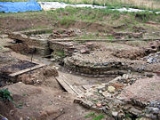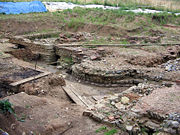
Tripontium
Encyclopedia
Tripontium was a town in Roman Britain
. It lay on the Roman road
later called Watling Street
(and known today as the A5) at a site now chiefly within the civil parish of Newton and Biggin in the English
county of Warwickshire
and partly in Leicestershire
, some 3.4 miles north-east of Rugby
and 3.1 miles south of Lutterworth
.
The name "Tripontium" means "the place of three bridges", in reference to nearby bridges over the River Avon
and two of its tributaries.
in 1836. Excavation works at the site were begun in 1961 by the Rugby Archaeological Society and have continued ever since.
 It was initially thought that Tripontium was a small wayside settlement of little importance; however, excavations of the site have revealed that it was an important Romano-British town, with large public bath houses
It was initially thought that Tripontium was a small wayside settlement of little importance; however, excavations of the site have revealed that it was an important Romano-British town, with large public bath houses
, an extensive administrative building and a mansio
(hotel) building. Numerous pieces of pottery
, Roman coin
s, and other remains have been found.
Unfortunately some of the area of the town has been destroyed by modern gravel extraction and part of the site is presently unavailable for excavation. Nevertheless, it seems highly likely that more buildings, such as the remains of a temple
or a forum
, remain to be found at the site. The excavation of Tripontium has been the largest of its type to be carried out by an amateur archaeological society.
Tripontium was probably the most important Roman settlement in the area. The town is located some 8 miles south of Venonae (High Cross): the point at which Watling Street crossed the Fosse Way
. The large size of the bath houses and mansio building have led historians to conclude that Tripontium is likely to have been an important stopping-place for travellers, both military and civilian. It was probably also an administrative centre for the surrounding area.
It is believed that at least one Roman emperor
visited Tripontium, as the town is listed in the Antonine Itinerary
, a third century document which recorded the journeys taken by the Emperors.
The site is not presently open to the public but many of the finds from the excavations are on display at the Rugby Art Gallery and Museum
.
Roman Britain
Roman Britain was the part of the island of Great Britain controlled by the Roman Empire from AD 43 until ca. AD 410.The Romans referred to the imperial province as Britannia, which eventually comprised all of the island of Great Britain south of the fluid frontier with Caledonia...
. It lay on the Roman road
Roman road
The Roman roads were a vital part of the development of the Roman state, from about 500 BC through the expansion during the Roman Republic and the Roman Empire. Roman roads enabled the Romans to move armies and trade goods and to communicate. The Roman road system spanned more than 400,000 km...
later called Watling Street
Watling Street
Watling Street is the name given to an ancient trackway in England and Wales that was first used by the Britons mainly between the modern cities of Canterbury and St Albans. The Romans later paved the route, part of which is identified on the Antonine Itinerary as Iter III: "Item a Londinio ad...
(and known today as the A5) at a site now chiefly within the civil parish of Newton and Biggin in the English
England
England is a country that is part of the United Kingdom. It shares land borders with Scotland to the north and Wales to the west; the Irish Sea is to the north west, the Celtic Sea to the south west, with the North Sea to the east and the English Channel to the south separating it from continental...
county of Warwickshire
Warwickshire
Warwickshire is a landlocked non-metropolitan county in the West Midlands region of England. The county town is Warwick, although the largest town is Nuneaton. The county is famous for being the birthplace of William Shakespeare...
and partly in Leicestershire
Leicestershire
Leicestershire is a landlocked county in the English Midlands. It takes its name from the heavily populated City of Leicester, traditionally its administrative centre, although the City of Leicester unitary authority is today administered separately from the rest of Leicestershire...
, some 3.4 miles north-east of Rugby
Rugby, Warwickshire
Rugby is a market town in Warwickshire, England, located on the River Avon. The town has a population of 61,988 making it the second largest town in the county...
and 3.1 miles south of Lutterworth
Lutterworth
Lutterworth is a market town and civil parish in the Harborough district of Leicestershire, England. The town is located in southern Leicestershire, north of Rugby, in Warwickshire and south of Leicester. It had a population of 8,293 in the 2001 UK census....
.
Character
Tripontium was initially a military frontier post, established soon after the Roman invasion of Britain around AD 50. It later developed into a civilian town which was inhabited for around 400 years before being abandoned in the late fourth century when the Romans left Britain.The name "Tripontium" means "the place of three bridges", in reference to nearby bridges over the River Avon
River Avon, Warwickshire
The River Avon or Avon is a river in or adjoining the counties of Leicestershire, Northamptonshire, Warwickshire, Worcestershire and Gloucestershire in the Midlands of England...
and two of its tributaries.
Excavations
The exact position of Tripontium remained a mystery for centuries, but it was located by the antiquarian Matthew BloxamMatthew Bloxam
Matthew Holbeche Bloxam , a native of Rugby, Warwickshire, England, was an amateur archeologist and Warwickshire antiquary. He was the original source of the legend of William Webb Ellis inventing the game of Rugby football....
in 1836. Excavation works at the site were begun in 1961 by the Rugby Archaeological Society and have continued ever since.

Thermae
In ancient Rome, thermae and balnea were facilities for bathing...
, an extensive administrative building and a mansio
Mansio
In the Roman Empire, a mansio was an official stopping place on a Roman road, or via, maintained by the central government for the use of officials and those on official business whilst travelling.-Background:The roads which traversed the Ancient World, were later surveyed,...
(hotel) building. Numerous pieces of pottery
Pottery
Pottery is the material from which the potteryware is made, of which major types include earthenware, stoneware and porcelain. The place where such wares are made is also called a pottery . Pottery also refers to the art or craft of the potter or the manufacture of pottery...
, Roman coin
Coin
A coin is a piece of hard material that is standardized in weight, is produced in large quantities in order to facilitate trade, and primarily can be used as a legal tender token for commerce in the designated country, region, or territory....
s, and other remains have been found.
Unfortunately some of the area of the town has been destroyed by modern gravel extraction and part of the site is presently unavailable for excavation. Nevertheless, it seems highly likely that more buildings, such as the remains of a temple
Temple
A temple is a structure reserved for religious or spiritual activities, such as prayer and sacrifice, or analogous rites. A templum constituted a sacred precinct as defined by a priest, or augur. It has the same root as the word "template," a plan in preparation of the building that was marked out...
or a forum
Forum (Roman)
A forum was a public square in a Roman municipium, or any civitas, reserved primarily for the vending of goods; i.e., a marketplace, along with the buildings used for shops and the stoas used for open stalls...
, remain to be found at the site. The excavation of Tripontium has been the largest of its type to be carried out by an amateur archaeological society.
Tripontium was probably the most important Roman settlement in the area. The town is located some 8 miles south of Venonae (High Cross): the point at which Watling Street crossed the Fosse Way
Fosse Way
The Fosse Way was a Roman road in England that linked Exeter in South West England to Lincoln in Lincolnshire, via Ilchester , Bath , Cirencester and Leicester .It joined Akeman Street and Ermin Way at Cirencester, crossed Watling Street at Venonis south...
. The large size of the bath houses and mansio building have led historians to conclude that Tripontium is likely to have been an important stopping-place for travellers, both military and civilian. It was probably also an administrative centre for the surrounding area.
It is believed that at least one Roman emperor
Roman Emperor
The Roman emperor was the ruler of the Roman State during the imperial period . The Romans had no single term for the office although at any given time, a given title was associated with the emperor...
visited Tripontium, as the town is listed in the Antonine Itinerary
Antonine Itinerary
The Antonine Itinerary is a register of the stations and distances along the various roads of the Roman empire, containing directions how to get from one Roman settlement to another...
, a third century document which recorded the journeys taken by the Emperors.
The site is not presently open to the public but many of the finds from the excavations are on display at the Rugby Art Gallery and Museum
Rugby Art Gallery and Museum
The Rugby Art Gallery and Museum is a combined art gallery and museum located in central Rugby, Warwickshire, in England.The purpose built building housing it which was opened in 2000 also contains the town's library....
.

